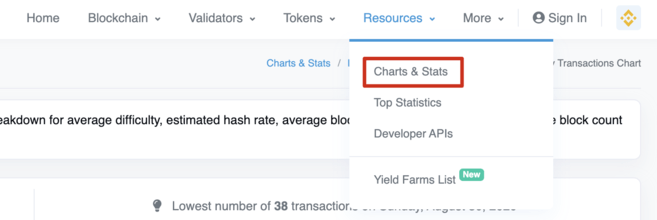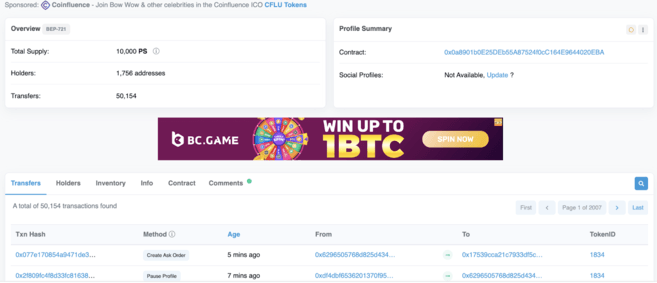TL;DR
BNB Smart Chain (BSC) has seen some steady growth in on-chain activity and usage. But what does that mean in terms of numbers? The beauty of a public blockchain is that they are… well, public. You can track the progress yourself.
Are you eager to keep tabs on BSC metrics but don't know where to start? No sweat, we've got the perfect guide on getting started with the BscScan block explorer. This way, you can keep a close eye on the growth of BNB Smart Chain.
You’ll find most of the features discussed in this article on the [Charts and Stats] page you can find by hovering over [Resources] on the toolbar. This includes daily transactions, unique wallet addresses, top tokens, and more. BscScan is also a great tool for looking up the validity of smart contracts and even checking out the latest NFT collections.
Introduction
We often talk about how public blockchains are permissionless, meaning that anyone with an address can interact with them. But did you know development on blockchains is permissionless too? Anyone with the relevant expertise can deploy their DApp on a blockchain, and there's no one stopping them.
This fact has led to fast development speeds in the Decentralized Finance (DeFi) space. BNB Smart Chain (BSC) is still a young blockchain, but it's already seen impressive growth. How impressive, you ask? Well, there's a lot of publicly available on-chain data, making it easy for traders and investors to check the network’s activity.
If you're looking to access this on-chain data, a blockchain explorer like BscScan is the easiest way to find everything you need.
What is BscScan?
BscScan (BscScan.com) is a blockchain explorer developed by the same team as Etherscan. It offers an analytics platform for BNB Smart Chain, but it also has many other neat features. These can be good sources of information if you want to keep an eye on DeFi projects built on BSC. You can also use BscScan to:
1. Look up transactions and check their progress.
2. See the latest blocks added to the blockchain.
3. Check the balance of wallets and any transactions they have made.
4. Search for, read, and interact with smart contracts deployed to the blockchain.
5. Research the supply of tokens and other cryptocurrencies.
All of this information is available without signing up and totally for free. A blockchain explorer just displays it all in a simple and easy-to-navigate way.
Why should I use BscScan?
BscScan comes from the trusted development team behind EtherScan, a popular Ethereum block explorer. Beyond its reputation, BscScan can help you navigate the blockchain. With some basic knowledge of how to use it, you can quickly troubleshoot basic problems and queries.
For example, knowing how to look up a smart contract on BscScan is a handy skill for anyone who uses DApps. You can see if their smart contracts are verified and even interact with them directly if the DApp's API is down. But there's more to on-chain information than just checking smart contracts and basic transactions.
For example, you could set up whale alerts to monitor large transactions. In some cases, a large amount of BNB moving onto an exchange might suggest that a sale is coming soon. You can even track the wallets of DeFi protocol founders to see if they are moving their tokens. Let's dive into some of the most commonly used tools and metrics that you can look up using BscScan.
How do I find BNB Smart Chain yield farms?
The BscScan yield farming dashboard shows you all the top current farming opportunities. You can access this by hovering over the [Resources] button and clicking on [Yield Farms List].

Here you can see the latest farms, where to access them, and how they work on their dedicated websites. Yield farming (or liquidity mining) is a way to generate crypto with your existing holdings. Using platforms like PancakeSwap, you can generate yield on BNB Smart Chain. Because fees are low on BSC compared to alternatives like Ethereum, BSC is ideal for smaller players to enter the yield farming scene and get their fair share of the available crops. But be careful because there are many scam projects out there. Make sure to DYOR and never risk funds you cannot afford to lose.

Another good resource for keeping track of all the different DApps in the BSC ecosystem is https://mathdapp.store/. Just select BNB Smart Chain on the sidebar on the left, and you'll get a list of trusted BSC DApps.
How do I find the BNB Smart Chain average gas price?
First, hover over [Resources], click [Chart & Stats], and then click [Average Gas Price Chart].

You’ll now see the average gas price chart used to calculate the gas fee that users pay for BSC transactions.

As we've mentioned, BSC has relatively low fees. In BSC, 1 gwei is 10-9 or 0.000000001 BNB. With an average gas price of around 6.5 gwei, sending 10 BNB should cost less than ten cents. In fact, sending ten or even a hundred times that amount still shouldn't cost you more than 20 cents.

From the transaction history, we can see that people have paid higher transaction fees than usual. Some users may have brought their old habits from Ethereum or other blockchains. It's really not necessary. BNB Smart Chain is still far from congested, so if network conditions remain stable, 6.5 gwei should be enough for a simple transaction.
How do I find the BNB Smart Chain unique address count?
BscScans's unique address count is an excellent metric to use if you want to estimate roughly how many users the network has. You can find the unique address count by hovering over [Resources] and clicking [Chart & Stats]. Next, click [Unique Addresses Chart].

So does it mean that if a blockchain has 100 unique addresses, it has 100 unique users? Absolutely not! Anyone can create multiple addresses. But thanks to the magic of cryptography, even if they did, we wouldn't run out of addresses for a long time. And even then, it would be quite tricky to find out if those addresses belong to the same entity.
So we know that anyone can create multiple addresses, and this metric is an overestimation of the number of users. Still, the unique address count can give us a rough idea of the network's growth.
How do I find BNB Smart Chain’s daily transaction amount?
This chart shows us the total number of transactions on BNB Smart Chain on a given day. Again, it’s available in the [Charts & Stats] section.

While some smart contracts require more transactions than others to execute, this chart can still give us an idea of the network's activity and if it could possibly be congested. It’s also a good sign of a healthy, growing network which can be useful information for BNB investors.
What are the top BEP-20 tokens?
The Token Tracker page lets you track the top BEP-20 tokens by market cap or daily trading volume. This will give you an idea of which tokens have the highest cumulative value on the BSC blockchain along with the highest trading volumes.

One thing to note here is the token information. Token/contract owners can update their token's information on BscScan to give you more details about the token. If the BscScan team hasn't verified the token contract address, it may not be trustworthy.
You'll see a lot of wrapped tokens on this page. Binance-Peg ChainLink (LINK) is just one example. This means that it's ERC-20 LINK wrapped as a BEP-20 token on BSC. Hang on, a wrapped version of what exactly? It's a tokenized version of a coin or token that belongs to another blockchain.
Wrapping allows coins and tokens that are not on BSC to be used in the Binance DeFi ecosystem. For example, if you're a LINK holder and want to use your LINK to farm on BSC, it’s easy for you to bridge over with the wrapping technology.
If you'd like to play around with wrapping tokens, check out the Binance Bridge Project. Note that while wrapping a coin is relatively easy, you don't always need to do it. You can simply trade already wrapped tokens without having to worry about the wrapping process yourself.
What are the top ERC-721 tokens?
You can also use the Token Tracker to look up the top ERC-721 tokens used on BNB Smart Chain. But hold on, you might be wondering why we're calling them ERC-721 tokens and not BEP-721? Well, both of these token standards are the same. BNB Smart Chain is a fork of Ethereum with some added changes, meaning that many token standards are identical. However, this doesn’t mean you will find the same tokens on both chains. BSC has its own set of ERC-721 (BEP-721) tokens.
By default, the list is sorted by the number of transfers in the past 24 hours.

Is BscScan compatible with NFTs?
Just like any other digital asset available on BSC, you can quickly look up individual NFTs and their smart contracts. BEP-721 and BEP-1155 tokens are BSC's most common standards for NFTs, so let's look at a quick example. Here's a PancakeSwap Pancake Squad NFT:

If we copy its contract address (0x0a8901b0E25DEb55A87524f0cC164E9644020EBA) into BscScan's search bar, we can see a lot of information about the series:

To name a few, we can look at any transfer of NFTs in this series, which wallet addresses hold them, and how many wallets have them. However, you won't be able to see the picture, song, file, or asset attached to the NFT. These aren't stored on the blockchain. The NFT's metadata will usually point to a third-party website or file hosting service where you can inspect the artwork or attached file.
How can I look up BNB Smart Chain validators?
In simple terms, validators are the ones that make sure that BSC keeps going. By staking BNB, they process transactions and confirm new blocks. In return for their service, they earn transaction fees that stem from network activity.
BNB Smart Chain relies on a consensus mechanism called Proof of Staked Authority (PoSA). This model of consensus can support a short block time and lower fees. You can check the top validators on BNB Smart Chain on the Validators Leaderboard under the [Validators] tab.

Who can become a validator? Well, basically anyone, but the requirements are relatively high. After all, the security of the network is at stake. If you'd like to read more about how to become a validator on BNB Smart Chain, check out the Binance Chain Docs guide.
How to verify smart contracts on BscScan?
Users of BscScan can enter any contract address to verify it and see if the compiled code is the same as the one running on this blockchain. It’s easy to spot - you’ll see a green tick next to the contract on the toolbar as well as a [Contract Source Code Verified] notice.

Allowing users to independently audit and verify code is a valuable feature, as it contributes to the overall transparency of the BNB Smart Chain ecosystem. You can also interact directly with smart contracts by connecting a browser wallet like MetaMask or Binance Chain Wallet.
Closing thoughts
Whether you're a DeFi veteran or completely new to yield farming on the BSC network, learning to use BscScan will help you better understand your way around a blockchain. However, keep in mind that the markets are irrational, unpredictable, and prone to periods of extreme volatility. Doing your own research is crucial to success in trading or yield farming. This can include checking whether a token is certified by the BscScan team, whether the contract is open-source and has been audited, and visiting the project's blog or social media accounts to get a deeper insight. Make sure you understand the risks of participating in DeFi before you jump in.

